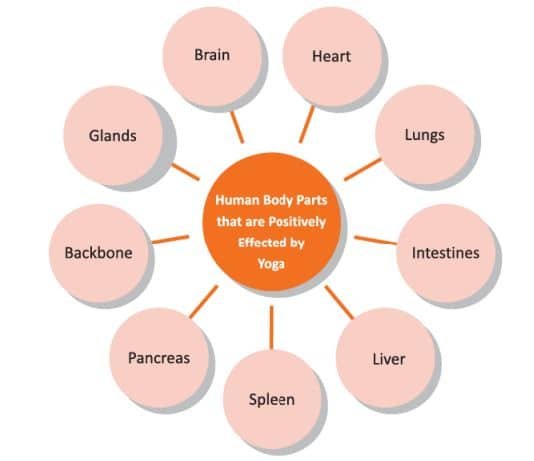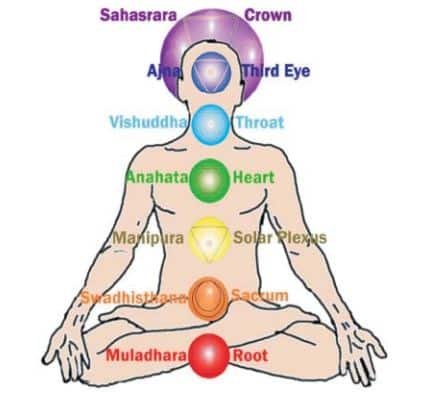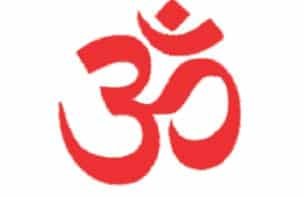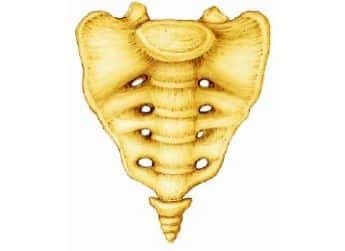The chapter “Introduction to Yoga and Yogic Practices Yoga (841)” helps students understand the true essence of yoga. It explains the meaning, origin, and significance of yoga, its objectives, as well as various yogic practices that contribute to a balanced lifestyle. This chapter is essential in building awareness about mental, physical, and spiritual well-being.
Introduction to Yoga and Yogic Practices Class 11 Notes
Yoga etymology, definition, aim, objective and misconception text

Yoga is a practical aid, not a religion. Yoga is an ancient art based on a harmonising system for the development of the body, mind, and spirit. In ancient India, yoga meant ‘union’, the balance between the mind, body and spirit, and it is also referred to as ‘asana’ in Sanskrit. The aim of yoga is to create balance between the body and the mind.
Foundational Concepts
- Yoga – Union; the integration of body, mind, and spirit.
- Asana – Physical posture or pose.
- Pranayama – Breath control; techniques for regulating the breath.
- Dhyana – Meditation or deep contemplation.
- Samadhi – A state of blissful absorption or enlightenment.
Common Terminology Used in Yoga
a. Asana: One of the important yogapaths, which has eight limbs in Ayurveda. Asana comes from the Sanskrit word meaning “posture” or “seat”. In yoga, chakras are considered important energy centres within the body. There are seven energy centres, “Chakras”, of the body, like muladhara, svadhishthana, manipura, anahata, vishuddha, ajna, sahasrara, etc.

b. Dosh: Dosh refers to the three fundamental energies. These are Vata (Air), Pitta (Fire) and Kapha (Earth).
c. Mudra: In yoga, a mudra is a symbolic hand gesture or hand position used to channel energy flow and for meditation.

d. Mantra: This is a group of words, chanted for creating positive environment meditation or dhyana. As per the Vedic beliefs, these words and chanting Om or AUM create energy in the body and make it disciplined.

e. Patanjali: Patanjali is revered as the father of classical yoga philosophy. Indian sage who compiled all yoga sutras, which were earlier scattered in different forms of Pranayama, types of breathing exercises in yoga, etc.
f. Power Yoga: It is a type of Ashtanga yoga which has more focus on fitness sacrum, a triangular-shaped bone situated at the base of the spine.

g. Samadhi: A state of meditation sadhana: spiritual discipline for getting siddhi shani: it means peace and is very frequently chanted during yoga practice. shodhana: a purification process in Hatha yoga sutras classical text for yoga created by yogis sukshma nadi: the central prana current svadhyaya: self-study ujjayi: sound of breath, taken from a slightly constricted throat; upanishad: ancient Vedic text written by Indian sages; vinyasa: a body movement linked with breath; yogi or yogini: disciple of yoga.
Definition of Yoga
According to the Maharshi Patanjali, yoga is about calming the busy thoughts in the mind. When the mind is quiet we experience peace. In the Bhagavad Gita, Lord Krishna teaches that yoga is doing our actions with focus and care without knowing the result. The Maitri Upanishad describes yoga as the harmony of our breath, mind and senses.
Aims and Objectives of Yoga
According to the Maharshi Patanjali, the Yoga Sutra’s ultimate goal is to reach Kaivalya, which means absolute freedom or liberation. In this state the person becomes completely free from the cycle of karma and rebirth. In this state you realise your self – the soul – which is peaceful and never-changing; all the things in the outside world are temporary, and true happiness comes from within.
Objectives of Yogic Practices
- To attain a higher level of consciousness
- To integrate moral values
- To practise mental hygiene
- To develop focus and concentration
- To boost self-esteem and confidence
- Strengthens the mind-body connection.
Misconception About Yoga
A few misconceptions about yoga are mentioned:
- Yoga is a type of religion.
- Yoga is an enchantment.
- Yoga means only renunciation (yaga) of the world (relations, duties, obligations).
- Yoga is to be practised and performed only by sanyasis (sages).
- Yoga is nothing but just various forms of meditation and nothing else.
- Yoga is confined only to asanas and pranayamas.
- Asanas and physical exercise are different nomenclature with the same benefit.
- Yoga always targets reducing weight.
- Yoga can be done anywhere and any time.
- Fit, rich and healthy people only can practise yoga.
YOGA: ORIGIN, HISTORY AND DEVELOPMENT
Yoga started in India thousands of years ago, even before any religion was created. According to old stories, Lord Shiva was the first yogi (called Adiyogi) and the first teacher (Adiguru). He shared his yogic wisdom with seven wise men called Saptarishis on the banks of a Himalayan lake called Kanti Sarovar. These seven sages then spread the knowledge of yoga to different parts of the world—like Asia, Africa, the Middle East, and South America.
Archaeologists have discovered seals from sites like Mohenjodara and Harappa. One of the most iconic finds shows a three-faced figure seated in a yogic pose, surrounded by animals.
History and Evolution of Yoga
There are many theories associated with yoga. In the Rig Veda and some of the evidence was found in the Indus-Saraswati civilisation that the “Rishi Munis” were previously doing meditation. Yoga is involved in four paths:
- Jnana Yoga
- Bhakti Yoga
- Karma Yoga
- Raj Yoga
After the Vedic Period, the great “Maharishi Patanjali” created one book, which is known as the “Patanjali Yoga Sutras”. Due to the evolution of yoga, it is divided into the following periods:
- Pre-Patanjali Period (Before 500 BC)
- Patanjali Period (500 BC to 800 AD)
- Post-Patanjali Period (800 AD onwards)
1. Pre-Patanjali Period (Before 500 BC)
It is the time of the Vedic period; all the Vedas and Upanishads were written in this period.
Veda – Vedas are considered the oldest written documents by a human. Vedas contain hymns, philosophy and guidance for life. This text was written in Sanskrit, and Sanskrit is the mother of all languages. There are four Vedas:
- Rigveda
- Yajurveda
- Atharvaveda
- Samaveda
Upanishads – The meaning of Upanishads is sitting down on feet, which means getting ‘shiksha’ or education. There are more than 200 Upanishads available.
2. Patanjali Period (500 BC to 800 AD)
Maharshi Patanjali compiled all Yoga in a book called “Yoga Sutras”. This book has a total of 196 sutras or formulas. The book has four segments called Samadhi Pada, Sadhana Pada, Vibhuti Pada and Kaivalya Pada.
- Samadhi Pada: In this segment Patanjali explains that samadhi means meditation.
- Vibhuti Pada: In this segment Patanjali explains the results of yoga.
- Kaivalya Pada: In this segment Patanjali explains the connection of yoga with body, mind and soul.
3. Post-Patanjali Period (800 AD onwards)
After the Patanjali period, it is known as the post-Patanjali period. After Patanjali, there were many yogis and saints who developed yoga. These saints and yogis created new forms of yoga, but the basics of yoga are the same in all the styles. Modern yoga is known as “Hatha Yoga” or “Physical Yoga”. This is related to “Kundalini Yoga”, which is part of “Raja Yoga”. Modern yoga is a mix of all four paths of yoga.
Contribution of Yoga Gurus in Spreading Yoga
Yoga has spread all over the world by great yoga teachers. B. K. S. Iyengar was the founder of the style of yoga known as “Iyengar Yoga” and was considered one of the popular yoga types. In modern days, Sri Sri Ravi Shankar and Swami Ramdev have contributed a lot to spreading yoga to the common household.
Rules and Regulations to be Followed by Yoga Practitioners
Yoga also has some basic rules. These rules should be followed in order to get optimum results from yoga. Some of the basic rules are:
- Age of Yoga: Yoga has no age limit; a person of any age can perform yoga.
- Ideal Place of Yoga: Yoga has to be performed in a quiet and properly ventilated room.
- Ideal clothes for yoga: Wear loose, light and comfortable clothes during yoga practice.
- Yoga Mat for Exercise: Yoga mats made of natural materials as well as folded blankets can be used for doing yoga. Blankets work as good insulators between your body and the earth.
- Ideal Diet for Yoga: There is no specification or diet rule for yoga. Eat natural food.
- Condition of Stomach: It is recommended that your stomach be empty while doing yoga. If not possible, then give 3 to 4 hours gap after your last meal for doing yoga.
- Way of breathing: During yoga, you should breathe through your nose, not from the mouth.
- Body Condition While Doing Yoga: The body should be free from fever or any other disease. If anyone is suffering from any disease, then consult with a doctor before practising yoga.
- Asanas in Inverted Position: The female practitioner should avoid doing any type of inverted position yoga, such as Shirshasana or Sarvangasana, during her period.
- Pain in Body while doing Yoga: If your body is getting pain, then you should immediately stop yoga and inform your instructor about it.
Unity in Diversity
“Unity in diversity” means people can be united even though they are different in culture, language, religion, ideas or appearance. These differences help to make our relationships and society richer and stronger. The more complex unity is based on the understanding that difference enriches human interactions.
- One should practise yoga calmly without any haste or exhaustion.
- One should try to practice yoga every day regularly, preferably at the same time.
- While practising yoga, one should concentrate on yoga alone and try to keep away the other thoughts.
- During the practice of yoga asanas, the dirt in the internal organs of the body is directed towards the urinary bladder, so soon after completing yoga, one should pass out the urine.
- During yoga practice, if anyone feels the need to answer a nature call, he/she must go and attend to it immediately.
- If one sweats during yoga practice, he/she should slowly wipe it out either with a cloth or with the palms.
- Pranayama should follow the asanas, and meditation should follow pranayama.
- Always lie on your back for 2 to 5 minutes with relaxed breathing after finishing yoga postures.
- Movements should be slow in every case; sudden movements should be avoided.
Do’s of Yoga
- Wake up early.
- Sleep well.
- Stay clean.
- Practice yoga on an empty stomach.
- Choose a good spot.
- Use a mat or cloth.
- Face the right direction.
Don’ts of Yoga
- Women have to avoid during menstruation or pregnancy.
- Don’t eat right before yoga.
- No shower or water immediately after yoga.
- Skip the yoga if you are not feeling well.
- No heavy workouts after yoga.
- Avoid dirty or smelly places for yoga.
- Don’t practise during strong winds or storms.
Major Benefits of Yoga
The benefits of yoga are
- Improvement in immunity – Protection from diseases
- Healthy Heart – Protection from Heart Problems
- Improved Body Flexibility – Protection from Injury
- Improved body posture
- Positivity in mind – Protection from hypertension, depression, etc.
- Weight reduction/weight increase – Body attains ideal body weight
- Improved Muscle Strength
- Improved Vitality
Introduction to Major Schools of Yoga (Janana Yoga, Bhakti Yoga, Karma Yoga, Patanjali and Hatha Yoga)
Streams of Yoga
Primarily, yoga has four paths. The Bhagavad Gita has details on the four paths. All the four paths have their own renowned followers. There are four paths listed below –
1 Raj Yoga
2 Bhakti Yoga
3 Janana Yoga
4 Karma Yoga
1. Raj Yoga
Raj Yoga is known as Raja Yoga; it is yoga of the mind and meditation. The goal of this yoga is to reach inner peace and spiritual freedom (called samadhi). The Raj Yoga is divided into two branches –
- Bahiranga Yoga: Bahiranga means ‘external’ or ‘outer path of yoga’. It is controlled by four limbs of Ashtang Yoga – Yama, niyama, asana, and pranayama. Sometimes the fifth limb, pratyahara, is also associated with this.
- Antaranga Yoga: Antaranga Yoga means internal or inner path of yoga. It is controlled by the last three limbs of Ashtanga yoga – dharana, dhyana and samadhi.
2. Bhakti Yoga
Ramanuja was a main follower of Bhakti Yoga. Bhakti yoga aims to help a person evolve emotional maturity, love for society and devotion (Bhakti). The path of bhakti yoga leads to satisfaction and calmness of mind. It is considered to be the easiest path among the four. The Bhagavad Purana provides us with nine forms of bhakti:
- Sravan (listening)
- Kirtana (praising)
- Smarana (remembering)
- Pada-sevasna (rendering service)
- Archana (worshipping)
- Vandana (paying homage)
- Dasya (servitude)
- Sakhya (friendship)
- Atma-nivedana (complete surrender of self)
3. Janana Yoga
Jnana Yoga is the path of knowledge. Jnana yoga focuses on self-inquiry, wisdom, and the realisation of the true self. The word “Jnana” means knowledge of wisdom in Sanskrit. One of the famous followers of this stream was Shankara. There are three phases in Janana Yoga:
- Sravana, the first phase, focuses on knowledge.
- Mañana, the second phase focused on understanding.
- Nididhyasana, the third phase, focused on experimentation.
In Janana yoga, the ultimate aim is to understand the reality of atma (soul) and the ability to differentiate it from the body.
4. Karma Yoga
The Bhagavad Gita remains the main source for the conceptual basis of karma yoga; it was later elaborated by Swami Vivekananda. This path focused on action without worrying about the results.
Actions are categorised as:
- Tamasik – Tamasik actions come from confusion, laziness, or ignorance. They are often careless or harmful and lead to negative results. For example, doing something out of anger or without thinking is a tamasik act.
- Rajasik – Rajasik’s actions are done with strong desire, selfish motives, or ego. These actions involve a lot of effort but are focused on personal success or recognition, like working only for praise or rewards.
- Sattvik – Sattvik actions are the purest. They are done calmly, without attachment, and with a peaceful mind. A sattvik action is not done out of hate or desire—it is done because it’s the right thing to do, without expecting anything in return.
Eight Limbs of Ashtanga Yoga (Patanjali)
The meaning of Ashtanga yoga is “eight-limbed yoga”. ‘Ashta’ means ‘eight’, and ‘anga’ means ‘limbs’. According to Patanjali, Ashtanga yoga is a step-by-step guide to purify the body and mind.
- Yama: Moral value,
- Niyama: Personal habits,
- Asanas: Body postures,
- Pranayama: Breathing exercises,
- Pratyahara: Control of the senses,
- Dharana: Concentration and focusing the mind,
- Dhyana: Devotion, Meditation on the Divine,
- Samadhi: Union with the Divine
Hatha Yoga
Hatha yoga means balancing two main energy channels in the body. The word “Ha” means the cool and calm energy from the left side, and “Tha” means the active and strong energy from the right side. These energies flow through invisible channels in our body called nadis.
Introduction to Yogic Practice (Sukshyam Vyayam, Surya Namaskar and Asanas)
Clothing to wear during yoga
One should wear comfortable clothes (preferably cotton clothes) during yoga exercise. The clothes should be loose enough to allow you to do all the stretching exercises and yoga poses.
Getting Ready for Yoga – Sukshma Vyayama
Before starting yoga, it is important to prepare the body and mind. Suksh tide helps to begin the exercises. Sukshma Vyayama helps to warm up the joints and muscles, increase blood flow in the body, especially in the brain and nervous system, and helps the body to become flexible and relaxed.
Breathing Practices
Following are the breathing practices:
- Hand in and out
- Hand Stretch Breathing
- Ankle Stretch Breathing
- Rabbit Stretch Breathing
- Tiger Breathing
- Dog Breathing
Disclaimer: We have taken an effort to provide you with the accurate handout of “Introduction to Yoga and Yogic Practices Class 11 Notes“. If you feel that there is any error or mistake, please contact me at anuraganand2017@gmail.com.
The above CBSE study material present on our websites is for education purpose, not our copyrights. All the above content and Screenshot are taken from Yoga Class 11 NCERT Textbook, CBSE Sample Paper, CBSE Old Sample Paper, CBSE Board Paper and CBSE Support Material which is present in CBSEACADEMIC website, NCERT websiteThis Textbook and Support Material are legally copyright by Central Board of Secondary Education. We are only providing a medium and helping the students to improve the performances in the examination.
Images and content shown above are the property of individual organizations and are used here for reference purposes only.
For more information, refer to the official CBSE textbooks available at cbseacademic.nic.in
